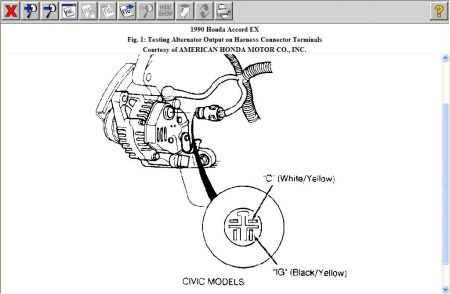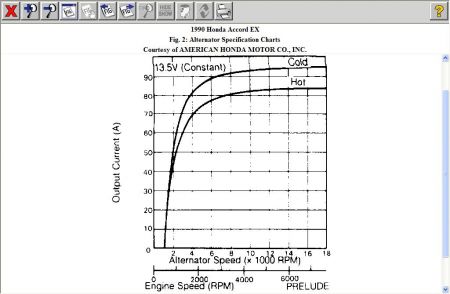Hi ducvanphung,
CHARGE WARNING LIGHT TEST
1. Perform preliminary inspection. Turn ignition on. If charge warning light comes on, go to step 3). If light remains off, remove alternator harness connector. See Fig. 1 . Using jumper wire, momentarily connect White/Blue wire terminal to ground.
2. If warning light now comes on, perform ALTERNATOR OUTPUT TEST . If warning light still remains off, check for burned bulb, open circuit in White/Blue wire, or open circuit in Black/Yellow wire between warning light and dash fuse box or between dash fuse box and ignition switch.
3. Start engine and allow to idle. If charge warning light goes out, turn off engine and go to step 4). If light remains on, perform ALTERNATOR OUTPUT TEST .
4. Turn ignition on. Disconnect alternator harness connector. Remove driver's side kick panel and integrated control unit. Charge warning light should go out.
5. If light goes out, integrated control unit is shorted. If light remains on, repair short circuit to ground in White/Blue wire between warning light and dash fuse box or between dash fuse box and alternator.

ALTERNATOR OUTPUT TEST
1. With engine at normal operating temperature, remove alternator harness connector. See Fig. 1 . Turn ignition switch to ON position.
2. Ensure battery voltage is present between Black/Yellow wire terminal of harness connector and ground. If battery voltage is present, go to step 4).
3. If battery voltage is NOT present, check dash fuse No. 2 (15A). Check for open circuit in Black/Yellow wire between dash fuse box and alternator.
4. Turn ignition off. Reconnect alternator harness connector. Connect alternator tester with integral carbon pile (to apply electrical load to system). Start engine. Ensure all accessories are off.
5. Operate engine at 2000 RPM and apply a load with carbon pile so voltage reading drops to no less than 12 volts (cooling fan must not come on while testing). Check maximum amperage and compare with appropriate alternator specification chart. See Fig. 2 .
NOTE: Due to engine operation, subtract 5-10 amperes from the maximum reading.
6. If amperage reading is within specification, charging system is okay. If amperage is NOT within specification, perform full field test.
7. Recheck amperage. If amperage is still NOT within specification, replace alternator. If amperage is within specification, internal voltage regulator is defective and must be replaced.

SPONSORED LINKS
Monday, August 24th, 2020 AT 2:41 PM


